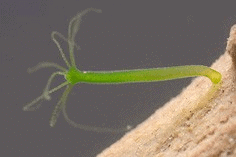Class 8 Science - Reproduction in Animals HOTS Questions
Q 1. Which of the following is not a unicellular organism?
A. Amoeba
B. Paramecium
C. Hydra
D. Yeast
 HydraQ 2. Which of the following shows budding?
HydraQ 2. Which of the following shows budding?
A. Yeast
B. Amoeba
C. Paramecium
D. Plasmodium
Q 3. Which of the following shows multiple fission?
A.Hydra
B.Yeast
C. Spirogyra
D. Plasmodium
Q 4. Which is the most common method of reproduction in the majority of fungi and bacteria?
A.Binary fission
B.Multiple fission
C.Budding
D.Spore formation
Q 5. Which of the following shows spore formation?
A. Amoeba
B. Mucor
C. Plasmodium
D. Paramoecium
Q 6. Regeneration is observed in ______.
A. Amoeba
B. Planaria
C. Spirogyra
D. Yeast
Q 7. Which of the following does not show regeneration?
A. Mucor
B. Planaria
C. Sponges
D. Starfish
Q 8. Which of the following is not an artificial method of vegetative propagation?
A.Cutting
B.Layering
C.Grafting
D.Hybridization
Q 9. Testes produce ______ hormone
A.Estrogen
B.Testosterone
C.Progesterone
D.Both estrogen and testosterone
Q 10. Which of the following is not produced in the ovary?
A.Ovum
B.Estrogen
C.Progesterone
D.Testosterone
Q 11. The main reproductive organ of human male is ______.
A. a pair of testes
B. Vas Deferens
C. urethra
D. penis
Q 12. The main female reproductive organ is ______.
A. Fallopian tubes
B. uterus
C. vagina
D. a pair of ovaries
Q 13. The first phase of the sexual cycle in human female is called ______.
A. ovulation
B. implantation
C. menstruation
D. follicle phase
Q 14. Menstrual flow(menstruation) lasts for about ______ days.
A.2 - 3
B.3 - 5
C.5 - 7
D.14
Q 15. In a normal healthy woman, menstruation occurs every ______ days.
A. 14
B. 28 - 32
C. 21 - 24
D. 270
Q 16. What marks the beginning of the reproductive life of a woman?
A. ovulation
B. menopause
C. menarche
D. fertilization
Q 17. What is formed after fertilization?
A.A sperm
B.An ovum
C.A zygote
D.A gamete
Q 18. Where does fertilization take place?
A.vagina
B.cervix
C.Fallopian tube
D.uterus
Q 19. What should be the normal weight of a fully matured foetus (child at birth)?
A.2.5 - 3.0 pounds
B.2.5 - 3.0 kg
C.3.0 - 3.5 pounds
D.3.0 - 3.5 kg
Q 20. ______ prevents ovulation.
A. Testosterone
B. Progesterone
C. Estrogen
D. Contraception
Q 21. Which of the following shows budding?
A. Hydra
B. Amoeba
C. Paramecium
D. Spirogyra
Q 22. Several new individuals are produced.
A. Binary fission
B. Multiple fission
C. Both binary fission and multiple fission
D. Fertilization
Q 23. In grafting the plant rooted in the soil is called ______.
A. stock
B. sucker
C. scion
D. rhizome
Q 24. Which of the following plants shows vegetative propagation?
A. Wheat
B. Radish
C. Sunflower
D. Bryophyllum
Q 25. Testes in human male are located in ______.
A. abdominal cavity
B. vas deferens
C. scrotum
D. penis
Q 26. In the process of sexual reproduction ______.
A. only males are needed
B. both male and female are needed
C. only females are needed
D. only mitosis is involved
Q 27. The process of release of an egg from the ovary is called ______.
A. reproduction
B. ovulation
C. menstruation
D. fertilization
Q 28. ______ takes place in a woman after 45 - 50 years.
A.Menstruation
B.Ovulation
C.Menopause
D.Lactation
Q 29. The period taken for one complete menstrual cycle is ______.
A.31 days
B.32 - 35 days
C.28 - 32 days
D.22 - 25 days
Q 30. The development of foetus inside the uterus till birth is called ______.
A.gestation
B.parturition
C.lactation
D.fertilization
Q 31. The unicellular fungus which shows bud formation is ______.
A. mucor
B. yeast
C. amoeba
D. none of these
Q 32. The animal which shows regeneration is ______.
A. amoeba
B. paramecium
C. hydra
D. rhizopus
Q 33. The method by which desired characters of two plants can be combined is ______.
A. cutting
B. layering
C. budding
D. grafting
Q 34. The disease caused by treponema palidium is ______.
A. AIDS
B. syphillis
C. gonorrhoea
D. hepatitis
ANSWERS TO MCQs:
(1) C (2) A (3) D (4) D (5) B (6) B (7) A (8) D (9) B (10) D (11) A (12) D (13) D (14) B (15) B (16) C (17) C (18) C (19) D (20) B (21) A (22) B (23) A (24) D (25) C (26) B (27) B (28) C (29) C (30) A (31) B (32) C (33) D (34) B
|
92 videos|296 docs|44 tests
|
FAQs on Class 8 Science - Reproduction in Animals HOTS Questions
| 1. What is reproduction in animals? |  |
| 2. How do animals reproduce sexually? |  |
| 3. What is asexual reproduction in animals? |  |
| 4. What are the advantages of sexual reproduction in animals? |  |
| 5. What are the different types of fertilization in animals? |  |

















